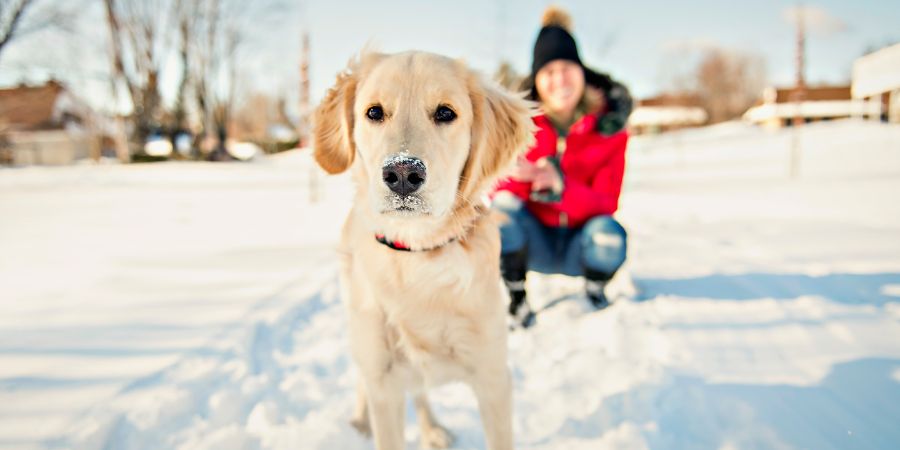Whilst it can be difficult to stay active when cold weather sets in, it’s important to make sure your dog is getting plenty of exercise. Here are some tips to make that easier for you.
Tip one: Dress your dog for cold weather
While many dogs aren’t at all bothered by wintery weather, some do struggle, and may benefit from a coat when outside in cold temperatures. No matter what their age or breed, with the right outdoor attire, your dog can enjoy the wonders of the winter season, come snow or shine.
If you’re unsure if a coat is suitable for your dog, we’ve created a guide to help you know if your dog needs the extra layers and how to get the perfect fit.
If your dog gets too cold, there’s a risk of hypothermia. However, it’s important to note that luckily this is very rare. If you are concerned about your dog, here’s how to spot the signs of hypothermia and how to prevent it from happening.
Tip two: Go on shorter walks

Even though the days are shorter and colder, and there may be wetter weather to contend with, there is no reason why you shouldn’t walk your dog. Keeping your dog active is an important part of their well-being, so you might just need to switch up your usual routine. Go for more frequent but shorter walks rather than one or two long walks per day to avoid long periods of time where your dog (and you!) are exposed to cold weather.
If your dog comes back when called on these shorter walks try to head for places where you can let them off their lead safely, to help them get their exercise in. However it’s important to only let them off when you are certain it’s safe to do so. Remember to keep your dog on their lead in built up areas, roads, and around livestock when on countryside walks. Keep them on the lead in unfamiliar areas too, as you won’t be certain there aren’t any hidden dangers like a lake or pond hidden underneath snow.
Reduced time outside walking may mean lowered activity levels if not substituted with other activity indoors, which can lead to weight gain. Keeping your dog at a healthy weight for their size and breed will ensure reduce the risk of them developing health conditions, or making existing health conditions worse.
Tip three: Play indoor games with your dog
If getting outside is proving tricky, why not try some indoor activity? Keeping their brain active and engaged will help to release some energy, and keep them active before they can get outside again. Here are some ideas for you to try:
- Feeding puzzles and snuffle mats are great for keeping your dog’s brain busy. These toys are designed for you to hide treats or their regular meals inside for your four-legged friend to find. It’s a good idea to have two or three different types and rotate them so your dog doesn’t become bored by the same challenge.
- Destruction boxes are great for dogs who like making a mess! All you need to do is fill a box or small container with bits of rolled-up newspaper and then hide some tasty treats or their regular meals inside. The game is for your dog to tear the box apart to get the food.
- Ball games like ‘fetch’ can be made more accessible using a dog-safe ball. Choosing the right size ball is essential to avoid potentially fatal choking incidents. The best balls to use are those on a rope so they can easily be retrieved from the back of the mouth if swallowed by accident. If you’re using a ball without a rope, choose one with a non-slippery surface and air holes, so if the worst happens, your pet’s airway wouldn’t be entirely blocked until the ball can be removed.
- Tug of war is also an excellent way for your dog to burn off excess energy if you’re physically able.
- Hide and seek can be a really fun way to get your dog using their amazing sense of smell to track you down in the house. It encourages movement, climbing stairs, and exploring too, providing some activity.
- Training helps keep your dog’s mind active and strengthens your bond. Why not use the extra time indoors to teach your dog something new?
- Indoor agility – try making a jump with some cups or boxes as supports and a broom or mop for the bar. See more on our blog.
Taking extra care in winter is advised but there isn’t anything that should stop your furry friend getting their much-needed outdoor exercise, especially when you’re cautious of the potential dangers you might face.
For information and advice on looking after your pet during winter, read our Pet Care in Winter page.
